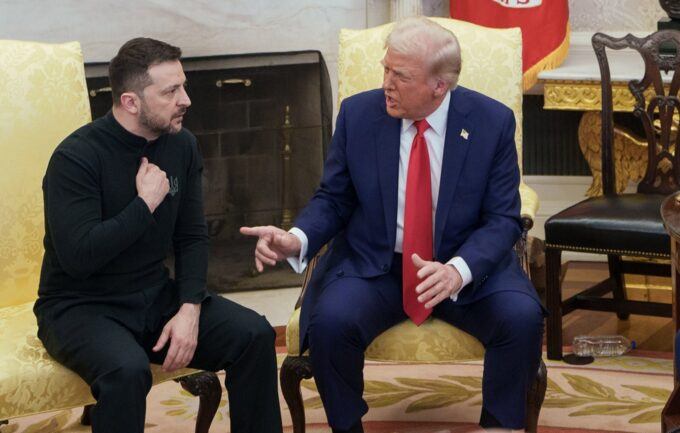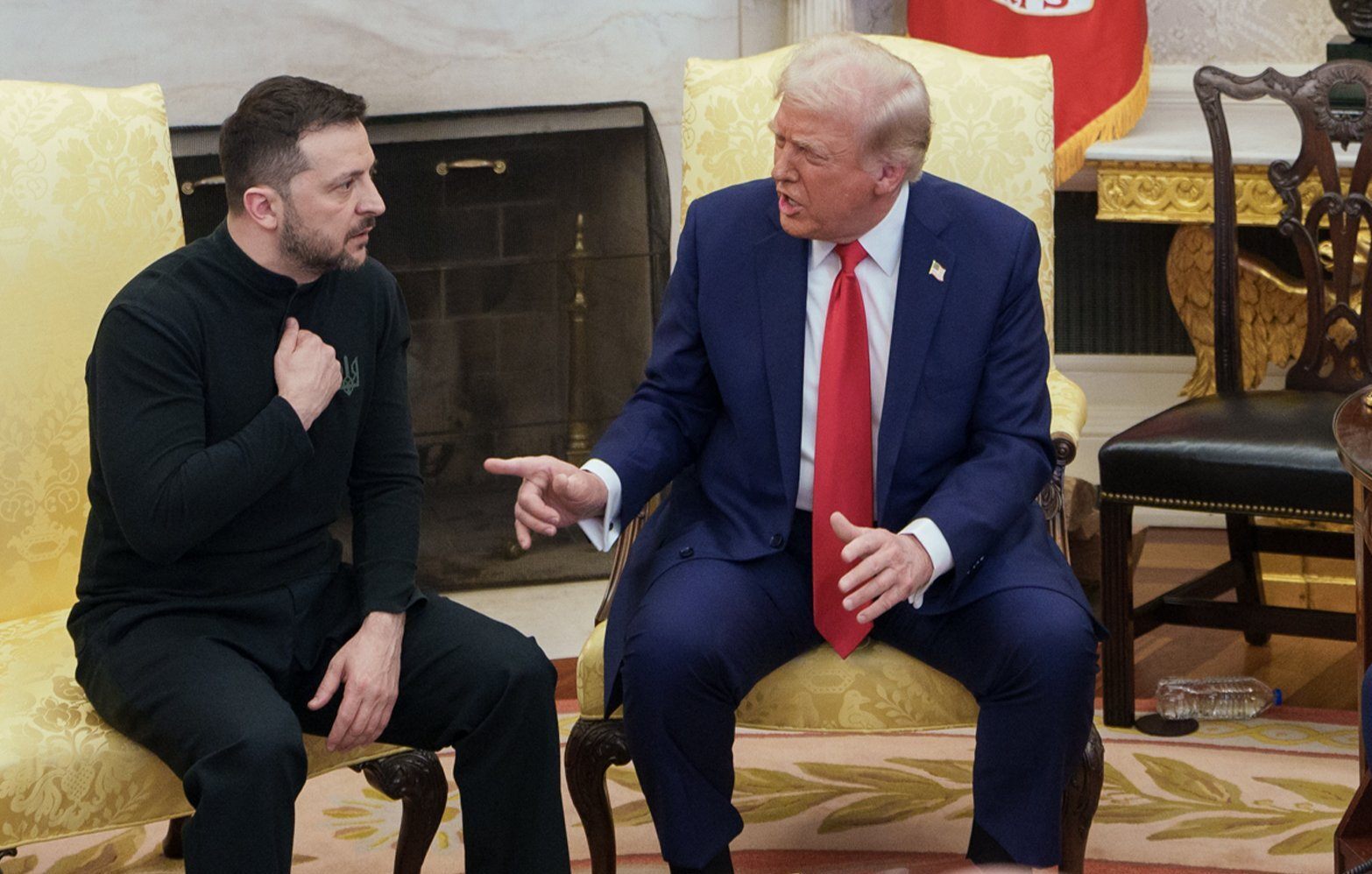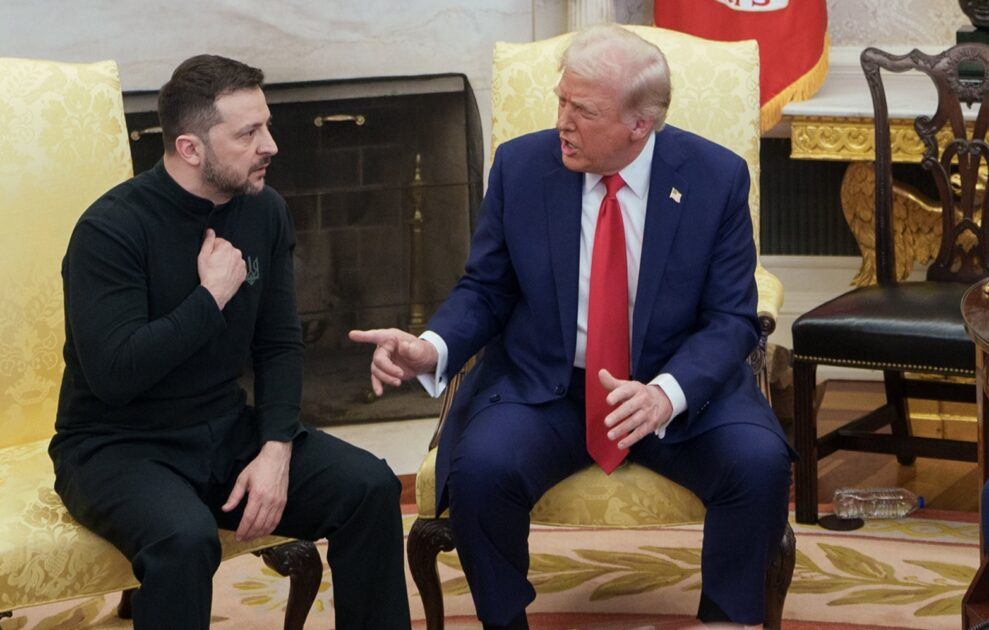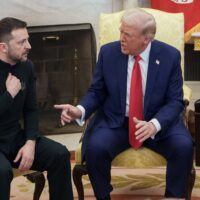






























































Photograph Source: The White House – Public Domain
Last week the Trump administration and Ukraine finally signed a deal on sharing Ukraine mineral rights. But a closer consideration of the published document shows this Mineral Deal 2.0 is fundamentally different from the 1.0 deal Trump proposed in February. One might more accurately call it a Trump capitulation.
In March Trump’s initial 1.0 deal was supposed to be signed in the White House with Ukraine’s president Zelensky. That meeting notoriously blew up with all the world watching in ascerbic verbal exchanges between Zelensky, Vice President JD Vance and Trump. Zelensky then left the meeting and immediately departed the US, flying directly to a meeting with British Prime Minister, Keir Starmer, who greeted him publicly with open arms and hugs.
In the White House meeting all sides were scheduled to announce the deal. But upon arrival Zelensky informed Trump he couldn’t agree. So the parties were in an agitated mood even before the meeting. Zelensky made a nasty comment in Ukrainian to Vance and it went downhill from there.
The essence of the March ‘Minerals Deal 1.0’s called for Ukraine to agree to using revenues from the exploitation its minerals would to repay the US for past military and economic aid to Ukraine. Trump estimated that amount at $350 billion. Other sources estimate around $100 billion. The actual amount no doubt somewhere in between. In any case no small amount of financial assistance.
Zelensky has always argued any such deal must be accompanied by a formal US security agreement with Ukraine. That was a precondition from the very beginning last October 2024 when Zelensky himself proposed a minerals sharing deal. However, the US has never linked a security agreement to the deal. The lack of a security clause in the agreement lay behind Zelensky’s reneging on the deal at the last moment when he arrived in the US for the White House meeting.
The Minerals Deal 2.0 signed last week shares little with Trump’s prior 1.0 offer. The 2.0, for example, explicitly excludes any use of the revenues from joint minerals exploitation to repay the US for back aid given Ukraine with no strings attached by the Biden administration.
This fact of no repayment for prior aid renders the 2.0 deal fundamentally different from Trump’s original proposal. And there’s more that differentiates the two deals.
Last week’s signed 2.0 deal creates an Investment Fund into which revenues from the exploitation of Ukraine minerals would be deposited. The Investment Fund also provides for the US and Ukraine to bear costs of minerals extraction 50%-50. However, while costs are shared 50-50 it says nothing about revenue sharing 50-50. In fact, reportedly the 2.0 deal is silent about how revenues will be shared, or if at all.
What the Investment Fund document does say about revenues is that all proceeds from the development and exploitation of Ukraine’s minerals will be deposited back into the Investment Fund in toto for the first ten years after the Fund is created. So all the revenues goes back into Ukraine; no revenues return to the US for repayment or, indeed, apparently for any reason.
One has to ask why has Trump completely capitulated, dropping his prior main demand for revenues compensating the US for back aid?
The language of the Investment Fund further allows either party, US or Ukraine, to deposit additional monies, apart from the revenues from the development of the minerals, into the Fund. Moreover—and here’s a most interesting provision—Ukraine has interpreted this additional contribution to the Fund to mean the US may contribute to the fund in the form of more weapons shipments to Ukraine. In other words, the value of the weapons would go to the US share of the 50-50 cost commitment. In addition, the US media has reported the 2.0 Deal includes the right of Ukraine to use its share of the Fund revenues to purchase US weapons.
In other words, this language suggests the Fund is intended to function as a back door to renewed US weapons shipments to Ukraine—thus reversing Trump’s past publicly declaration he would not agree to any more shipments of weapons to Ukraine.
Not coincidentally, within days of the deal signing the US media has reported that the US has resumed issuing licenses for future weapons shipment to Ukraine. And that the US will provide supplies for the F-16 jets from Denmark given to Ukraine. Then there’s the recent revelation that the US has arranged for Israel and Germany to send Ukraine two US Patriot Missile systems? That does not include the missiles themselves. Only the US can provide that and likely will soon.
Another curious feature is the Minerals 2.0 capitulation agreement is only one of the three documents involved in the agreement has been published. That’s the Investment Fund. So where are the other two? What do they say? And why are the media and politicians not demanding the other two ‘silent’ documents be published? Was perhaps more conceded by Trump that he does not want revealed?
It’s curious that all these terms of the Minerals deal quickly fell in place after Trump’s meeting with Zelensky at the Vatican last week as both attended the funeral of Pope Francis. A convenient photo op was published and distributed around the world showing Trump and Zelensky sitting on chairs face to face in the Vatican. Thereafter, within 24 hours the Minerals deal is announced!
Does anyone think this timing was mere coincidence? Or believe the media’s spin that Zelensky was able to button-hole Trump at the funeral at the last moment, get a meeting, and convince Trump to sign the Minerals deal with all the terms specifically benefiting Ukraine—i.e. no revenues repaying the US for past aid, cost sharing but no revenues sharing for any reason, a backdoor to future US weapons shipment, two of the three documents unpublished, and who knows what else?
Is the Investment Fund really about financing future joint development of Ukraine minerals and Ukraine economy’s redevelopment? Or is it a vehicle for enabling Ukraine to buy more US weapons?
In any event, Minerals Deal 2.0 has little resemblance to Trump’s original Minerals Deal 1.0. What it does resemble, however, is a major capitulation by Trump to Ukraine and Zelensky.
The question is why the capitulation to Zelensky and Ukraine? There are several possible explanations floating around. Here’s a couple.
First, some say it’s just another Trump big grift. That he’s creating a Fund he’ll somehow find a way to personally exploit. I don’t believe so. Those who suggest that must show how he intends to get at a Fund that appears locked up for ten years in Ukraine’s favor.
Another explanation is that the real language governing the deal is contained in the two documents that haven’t been made public. The other two docs are more demanding of Ukraine and pro-US. But that’s pure conjecture. One would have to see what the other documents actually say and it’s not likely the contents will appear any time soon.
Another is that the US neocons, Europeans, and Zelensky all ganged up on Trump in Rome at the funeral and, as appears so often in the case of Trump, got to him last and turned him around. That’s plausible. Trump is notorious for making decisions based on the latest advocates who get his ear.
This writer believes, however, that the Minerals 2.0 deal is a way for Trump to show some progress on the question of Ukraine and the war. Trump and his team have dedicated no small effort to pushing his ‘Kellogg Plan’ as the basis for a ceasefire and for commencing negotiations between Ukraine and Russia. The Kellogg Plan collapsed just days before the signing of Minerals Deal 2.0. And there’s no indication it will ever be resurrected. That collapse has to have had some influence on Trump’s capitulating on the Minerals deal.
The Kellogg Plan collapsed mostly because Zelensky refuses to talk until Russia unconditionally ceases fire, during which Zelensky retains the right to re-equip, re-store military personnel, and re-position military units as he pleases. Russia’s position is it will negotiate anytime and place but ceasefire is a subject of discussion after negotiations begin. Europe’s leadership agrees completely with the Zelensky position on the matter of ceasefire.
Other positions of the two parties, Ukraine and Russia, put them even further apart as well: Zelensky demands Russia give up all territories occupied before negotiations; Russia declares the four regions and Crimea are now part of Russia and by its constitution cannot negotiate giving away any part of the country. In addition, Russia demands Ukraine demilitarize and declare it won’t join NATO; Zelensky rejects either notion as not a subject for negotiation.
In other words, Trump’s Kellogg Plan was fundamentally naïve as a basis for any ceasefire or negotiations. It’s not surprising it collapsed. That Trump pushed it so long suggests he’s received bad advice or that the plan was always just a cover for other negotiations.
The collapse of the Kellogg Plan made Trump appear as if he was now at a ‘dead end’ in his efforts to mediate the war and unable to deliver on his campaign promise to end the war in 24 hours by getting the parties together and, to borrow a phrase, ‘making both sides an offer they couldn’t refuse’. The plan collapse reveals the US no longer has the level of influence it once did at the height of its imperial power at the start of the 21st century. The world has moved on. The US is relatively weaker; the rest of the world relatively stronger. Trump appeared weak with the collapse of the Kellogg Plan.
The Minerals 2.0 deal is therefore a substitute event, to enable Trump to show events are not at a standstill. He has not yet failed in his campaign promise. Not all is at fundamental impasse.
Trump’s alternatives at this point is either to follow the advice of his neocon advisers and provide Ukraine with more weapons and threaten the Russians that more US actions are forthcoming if they don’t come to the negotiating table. But this is essentially the Biden plan which produced no results for the prior three years. It is also the US neocons’ position real Plan A. They may have gone along with the Kellogg Plan B knowing full well it would collapse.
Trump’s other choice is to follow the advice of others like Witkoff and Vance in his administration to cut Ukraine loose and end all current US military assistance. Let events evolve on the ground for the next six months and intervene again later this year when one or both parties, Ukraine and/or Russia, are more amenable to a compromise.
Trump now appears drifting in the direction of the neocons’ plan to resurrect Plan A somehow and away from the opposing view that the only choice is to cut losses and let the Europeans have their war in Ukraine if they want.
As this article is written, reports are that Trump now wants a direct face to face meeting in May with Putin in Saudi Arabia in May. This suggests either he’s not too confident he’s directly getting the facts from his neocon advisers; or perhaps he thinks he can hammer out a deal over the table with Putin—as if he were concluding some kind of corporate acquisition where both sides ‘horse trade’ the main remaining unresolved issues on the table at the 11th hour to seal a deal.
If the latter, he’ll have some difficulty convincing the Russians he’s not just another western politician who makes promises, even signs documents, on which he then reneges—just as occurred in 2015 with the Minsk II agreement and again in Istanbul in 2022 when the war could have ended were it not for European NATO intervention convincing Zelensky to continue the conflict.
The post Trump’s Ukraine Minerals Deal 2.0 Capitulation appeared first on CounterPunch.org.
This post was originally published on CounterPunch.org.